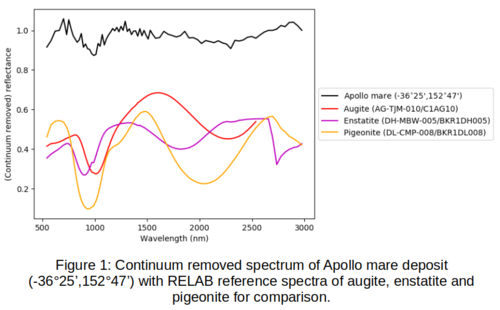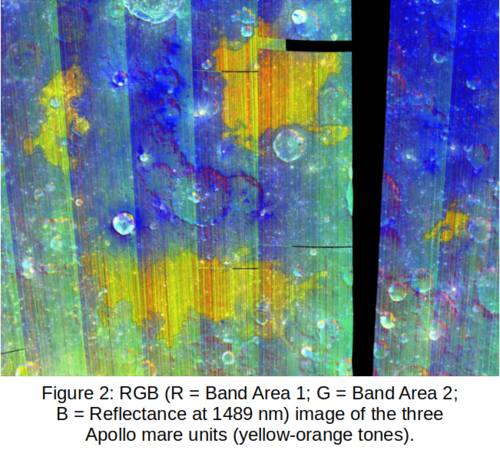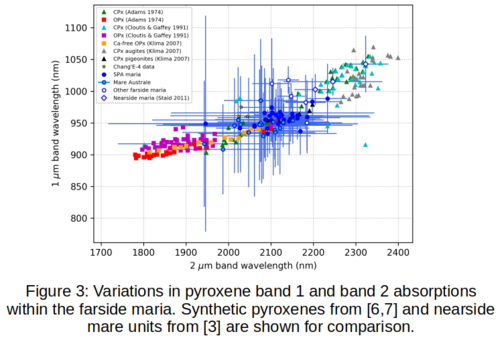Unveiling the mineralogical composition of lunar farside mare basalts
- 1CRPG, CNRS/ Université de Lorraine, 54500 Vandœuvre-lès-Nancy, France (nicolas.bott@obspm.fr)
- 2LGL, TPE, CNRS/ Université de Lyon, 69622 Villeurbanne Cedex, France
1. Introduction
One of the Moon’s most surprising characteristics is its crustal asymmetry; the farside hemisphere, dominated by ancient highlands and covered with a few mare deposits, has a different volcanic history than the (sampled) nearside [1]. Surface dating of the lunar mare basalts revealed that the volcanism on the Moon lasted between ~3.9-4.0 and ~1.2 Ga, with a peak in the volcanic activity ~3.6-3.8 Ga ago [2]. A recent study further demonstrated that the mineralogy of the nearside mare basalts reveals a late stage volcanism with high titanium and olivine contents [3]. More recent spectroscopic analyses focused on the farside’s crustal rocks composition (e.g. [4] for South Pole-Aitken [SPA] basin), but no comprehensive study of the farside mare compositions has been conducted up to now.
2. Data and methods
In this work, we used spectroscopic data of the Moon Mineralogy Mapper (M3) onboard Chandrayaan-1 to survey the mineralogy of all mare deposits in the VNIR domain (0.4-3 μm). Each mare unit was mosaicked separately and processed using the method of [5]: an IDL routine automatically computes and removes the continuum of each spectrum, and determines its spectral parameters (e.g. band centers, band areas, band depths, spectral slope). To compare with the mineralogy of the nearside [3], we also mosaicked three selected mare regions, each representative of one spectral unit. Finally, we applied statistics on spectral parameters of interest to survey the variation in mineral signatures and compositions of farside maria.
3. Preliminary results
We found that spectra of mare basalts are dominated by pyroxene signatures (Figure 1).

However, some mare units (e.g. Apollo, see Figure 2) showed considerable differences in band characteristics in which cases we computed statistics on each mare subunits.

Major differences were also observed in SPA mare units when they were compared to Mare Australe deposits and other maria outside of the SPA basin (Figure 3).

This suggests different pyroxene compositions within SPA. Moreover, the nearside mare units we defined based on [3] are clearly distinct from all farside mare deposits since they are the richest in clinopyroxenes (Figure 3).
4. Conclusion and perspectives
The results we have so far indicate slightly different mineralogies of mare basalts between the nearside and the farside of the Moon and, if confirmed by looking at the other spectral parameters, could mirror its crustal dichotomy. We plan to investigate possible evidence of olivine and possible correlations with age and location, as well as intra-SPA diversity with our spectral parameters set.
Acknowledgements
The authors want to thank Jan Hendrik Pasckert and Harald Hiesinger for having kindly shared with us their shapefiles of SPA mare deposits [8]. Fundings from the CNRS Momentum, LUE Future Leader and CNES APR are much appreciated.
References
[1] Head III, J. W., and Wilson, L.: Lunar mare volcanism: Stratigraphy, eruption conditions, and the evolution of secondary crusts, Geochimica et Cosmochimica Acta, Vol. 56, 1992.
[2] Hiesinger, H., et al.: Ages of mare basalts on the lunar nearside, Journal of Geophysical Research, Vol. 105, 2000.
[3] Staid, M. I., et al.: The mineralogy of late stage lunar volcanism as observed by the Moon Mineralogy Mapper on Chandrayaan-1, Journal of Geophysical Research, Vol. 116, 2011.
[4] Moriarty, D. P., and Pieters, C. M.: The Character of South Pole-Aitken Basin: Patterns of Surface and Subsurface Composition, Journal of Geophysical Research, Vol. 123, 2018.
[5] Martinot, M., et al.: Mineralogical Diversity and Geology of Humboldt Crater Derived Using Moon Mineralogy Mapper Data, Journal of Geophysical Research, Vol. 123, 2018.
[6] Klima, R. L., et al.: Spectroscopy of synthetic Mg-Fe pyroxenes I: Spin-allowed and spin-forbidden crystal field bands in the visible and near-infrared, Meteoritics & Planetary Science, Vol. 42, 2007.
[7] Adams, J. B.: Visible and near-infrared diffuse reflectance spectra of pyroxenes as applied to remote sensing of solid objects in the solar system, Journal of Geophysical Research, Vol. 79, 1974.
[8] Pasckert, J. H., Hiesinger, H., Van der Bogert, C. H.: Lunar farside volcanism in and around the South Pole-Aitken basin, Icarus, Vol. 299, 2018.
How to cite: Bott, N., Flahaut, J., Martinot, M., and Ito, G.: Unveiling the mineralogical composition of lunar farside mare basalts, Europlanet Science Congress 2020, online, 21 September–9 Oct 2020, EPSC2020-561, https://doi.org/10.5194/epsc2020-561, 2020

